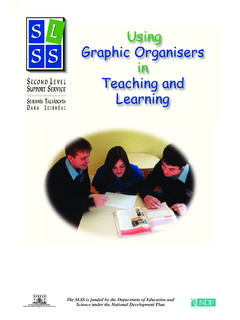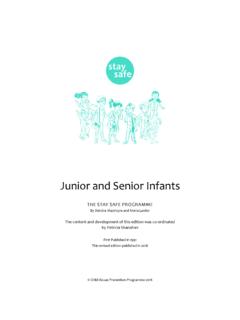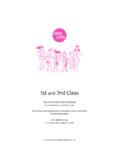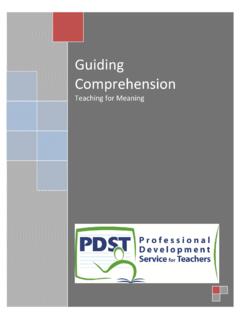Transcription of Differentiation in action! - PDST
1 1 Differentiation in action! 2 Introduction 3 Contextualising Differentiation 3 Your role as teacher in differentiating teaching 4 and learning: 1. Knowing your students 4 2. Organising your classroom 5 What might a differentiated classroom look like? 7 Differentiation strategies in action! 8 1. KUDo S 8 2. Bloom s Taxonomy 10 3. Tiered assignments 13 4. Flexible grouping 16 5. Tic-tac-toe boards 18 6. Use of ICT 19 7. Varied questioning 20 Towards a whole-school approach 21 Appendices 1. KWL chart template 23 2. Bloom s taxonomy: a framework for questioning 24 Bibliography 25 Table of contents 3 Introduction No two children are alike. Based on this principle differentiated teaching and learning is key to ensuring that children have multiple options for taking in information and making sense of concepts.
2 To differentiate effectively and support individual and diverse students in the classroom, the teacher is required to be flexible in their approach in order to adjust: The resource aims to contextualise Differentiation and to suggest a number of strategies to support differentiated teaching and learning in the classroom. Contextualising Differentiation So what exactly is Differentiation ? Heacox (2002) defines Differentiation as changing the pace, level, or kind of instruction you provide in response to individual learners needs, styles or interests while Willis, S. & Mann, L., (2000) states that Differentiation is a teaching philosophy based on the premise that teachers should adapt instruction to student differences . In discussing Differentiation some educationalists argue that Differentiation should be about matching the level of the curriculum content to the differing capabilities of the children.
3 Others argue that it is less about changing the level or type of work set by teachers but more about providing alternative paths to enable all children to reach their potential. Reducing the complexity and demands of the curriculum and setting easier objectives may sound like very good advice but watering down the curriculum in this way can have a long-term effect of increasing the achievement gap between children with learning difficulties and others. Similarly if advanced learners are merely assigned additional tasks to keep them busy they will continue to simply relearn the known. what the children will learn (content), how the children will learn (process) and, how they will demonstrate their learning (product). Remember! It is not the quantity but the quality of the task that should serve to extend children s learning.
4 4 Your role as teacher in differentiating teaching and learning An obvious feature of the differentiated classroom is that it is child centered . Shifting the emphasis from the teacher and instruction focus to the child and learning focus means redefining your role as teacher. As a teacher who differentiates instruction, you become both a facilitator and a collaborator (Heacox, 2002). Your role as teacher in the differentiated classroom is multi-faceted. As a facilitator, you provide a range of differentiated learning experiences for the children, you organise the children for learning and use time flexibly to suit children s needs. As a collaborator, you forge professional relationships with your colleagues and the children s families sharing insights, resources and ideas.
5 To enhance Differentiation in your classroom it is important that you: To ensure that your role as teacher does not become too over-whelming some teachers find it useful to choose from a menu of ideas such as those described in the subsequent pages of this document. Trial this selected idea, integrating your chosen strategy into your classroom in some way and sharing it with fellow teachers. 1. Knowing your students The biggest mistake in teaching is to treat all children as if there were variants of the same individual and thus to feel justified in teaching them all the same subjects in the same way. (H. Gardner) The first step in knowing the children in your class is to understand who they are, what they already know and understand. The following suggestions may be useful to support you in eliciting children s current understandings, knowledge, skills and interests: 1.
6 Know your students their interests, preferred learning styles, current level of knowledge and skills 2. organise your classroom physical environment, flexible grouping, agreed procedures/systems to facilitate independent learning 5 Assessment in the Primary School Curriculum; Guidelines for Teachers (NCCA, 2007) contains very useful information in relation to many of the suggestions above. Spending time getting to know your students is time well-spent as it informs your planning when deciding: Whose needs are not being met with this learning experience? Is this learning experience necessary for all the children in my classroom? How am I meeting the needs of children who already understand this material or who learn quickly? 2. Organising your classroom Carefully planned organisation of your classroom is key to complementing differentiated teaching and learning and providing children with choices in terms of their learning.
7 Such organisation will facilitate the use of flexible grouping (the practice of using several kinds of grouping formats at different times) and the early introduction of systems and procedures to support this is crucial. According to Fountas and Pinnell (1996), in short, an organised and well-designed classroom enables the teacher to observe, support, and meet the learning needs of each child. Teacher observation Focused talk and discussion Questioning Teacher designed tasks and tests KWL grids reference appendix A Brainstorming Standardised tests Diagnostic tests Concept mapping Profiles and inventories Questionnaires and surveys Self assessment and reflection Conferencing with parents and children Feedback from previous/other teachers Samples of children s work 6 Establish systems and procedures early in the year - teach children how to arrange the furniture according to two/three floor plans to facilitate groupwork Teach group work skills such as listening, turn-taking, welcoming all contributions, etc.
8 Explicitly Define areas of the classroom for independent and group work. If space allows, each child should have a home base desk that they return to for whole-class teaching. Establish flexible groups this is addressed in subsequent pages Teach children how to access resources and tidy them after use Ensure open shelving is accessible and within easy reach of the children Establish a rota for class jobs, access to library, maths, writing areas Colour-code activities and books Vary classroom instruction approaches to include whole-class, small-group and individual activities Ensure a whiteboard and blackboard is available for whole-class/small-group teaching Create a Things to Do chart for early finishers (self-correcting activities, webquests, varied journal prompts)
9 Consider introducing team-teaching in your classroom Ensure computer/laptop is accessible to children Involve children in maintaining and updating their own portfolios The following points may support you in organising your differentiated classroom: Please refer to the document entitled Promoting group work, collaborative and co-operative learning in the primary school - tip sheet for teachers for more information on group work and strategies to teach children group work skills. This is available on under the cross-curricular section. 7 What might a differentiated classroom look like? You might like to consider modifying a floor plan such as the example below when organising your classroom for Differentiation . The teacher stations are useful when working with small groups and can also be used during team-teaching.
10 Alternatively they can be used as learning centres. Aim to position low-level open shelving near such spaces so that needed materials are easily accessible and endeavour to organise the furniture so that desks can be manipulated thus allowing children to work independently, in small groups, or in pairs. The inboxes can be used to store materials or as places where children hand in work. Consider labeling or color coding the inboxes to help children find things quickly without the help of the teacher. Always keep a schedule and group assignments posted. The red circles represent pillows/mats so children can work on the floor if it meets their learning profile. Create structure around this (for example, they pick one place and stay there for a defined period of time). Inboxes Whiteboard Teacher Station 1 Bookshelf Teacher Station 2 Group assignments Schedule Blackboard 8 Differentiation strategies in action!














